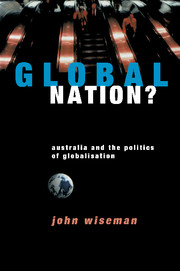Book contents
- Frontmatter
- Contents
- Abbreviations
- Acknowledgments
- 1 Introduction: Australia and the Politics of Globalisation
- 2 Breaking the Spell? Understanding Globalisation
- 3 Transforming the Global Economy? Trade, Capital and Power in the Late Twentieth Century
- 4 Onto the Global Racetrack? Globalising the Australian Economy
- 5 The Price of Competitiveness? The Social Impact of Globalisation on Australia
- 6 Wired to the World? Australia and the Globalisation of Media and Information Technologies
- 7 Nowhere to Hide? Australia in the Global Environment
- 8 Where in the World? Transforming Australian Political Relationships and National Identities
- 9 Alternative Strategies? Thinking and Acting Globally and Regionally
- 10 Alternative Directions? Thinking and Acting Locally and Nationally
- 11 Conclusion
- Notes
- Bibliography
- Index
4 - Onto the Global Racetrack? Globalising the Australian Economy
Published online by Cambridge University Press: 20 May 2010
- Frontmatter
- Contents
- Abbreviations
- Acknowledgments
- 1 Introduction: Australia and the Politics of Globalisation
- 2 Breaking the Spell? Understanding Globalisation
- 3 Transforming the Global Economy? Trade, Capital and Power in the Late Twentieth Century
- 4 Onto the Global Racetrack? Globalising the Australian Economy
- 5 The Price of Competitiveness? The Social Impact of Globalisation on Australia
- 6 Wired to the World? Australia and the Globalisation of Media and Information Technologies
- 7 Nowhere to Hide? Australia in the Global Environment
- 8 Where in the World? Transforming Australian Political Relationships and National Identities
- 9 Alternative Strategies? Thinking and Acting Globally and Regionally
- 10 Alternative Directions? Thinking and Acting Locally and Nationally
- 11 Conclusion
- Notes
- Bibliography
- Index
Summary
When Australia opted for an open economy, the nation committed itself to succeed in an endless race to become, and remain, globally competitive.
Working Nation (Commonwealth Labor Government White Paper on Employment)That is globalisation; billions of dollars traded across screens, every word of policy makers flashed around the globe to inform buyers and sellers in capital markets operating in different time zones trading a nation's stocks, bonds, or currency, and reacting to economic policy.
Australian Treasurer, Peter CostelloWe are in Dandenong to stay, provided Dandenong is efficient and competitive.
Dr. T. O'Reilly, Managing Director, Heinz AustraliaAt the time of the Hawke Labor Government's 1983 election victory the Australian economy was still a highly protected ‘farm and quarry’. It was heavily reliant upon agricultural and mining exports and had a small, uncompetitive manufacturing sector focussed mainly on the domestic market. The Australian welfare state remained a fragile and residual creation based upon assumptions of full employment for men and relatively high wage levels defended by centralised wage fixing.
The story of economic relationships and policies in the 1980s and 1990s in Australia is one of the shattering of the assumptions upon which the settlement between labour and capital was constructed. By the end of the 1990s, Australians were living and working in a deregulated economy in which long-standing principles of security and stability had been over-whelmed by the new mantra of ‘competitiveness in a globalised world’.
- Type
- Chapter
- Information
- Global Nation?Australia and the Politics of Globalisation, pp. 40 - 55Publisher: Cambridge University PressPrint publication year: 1998

